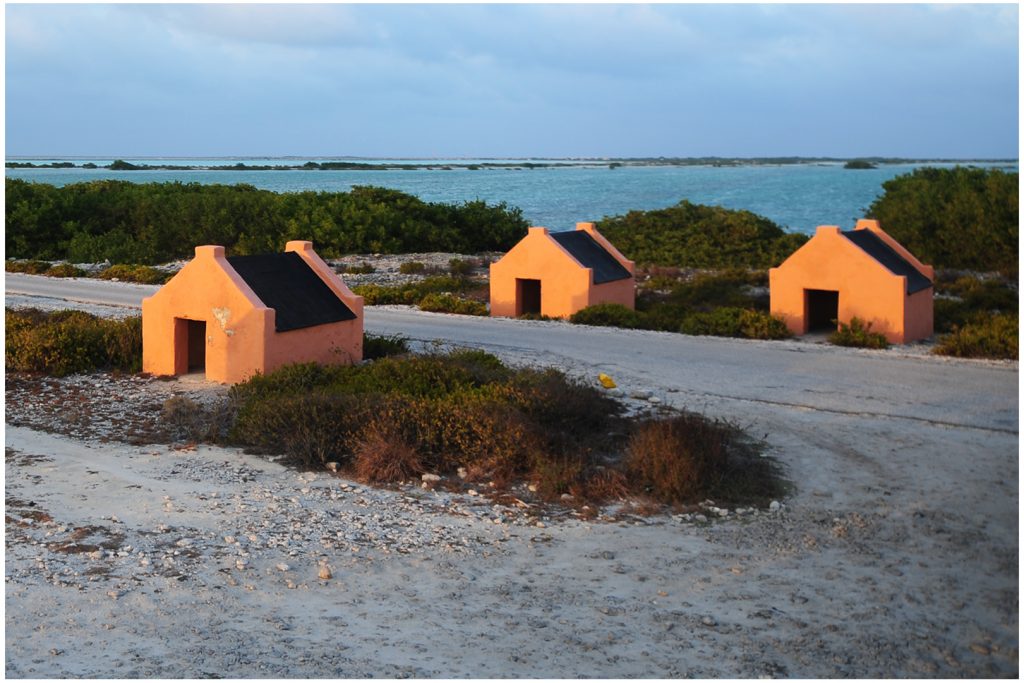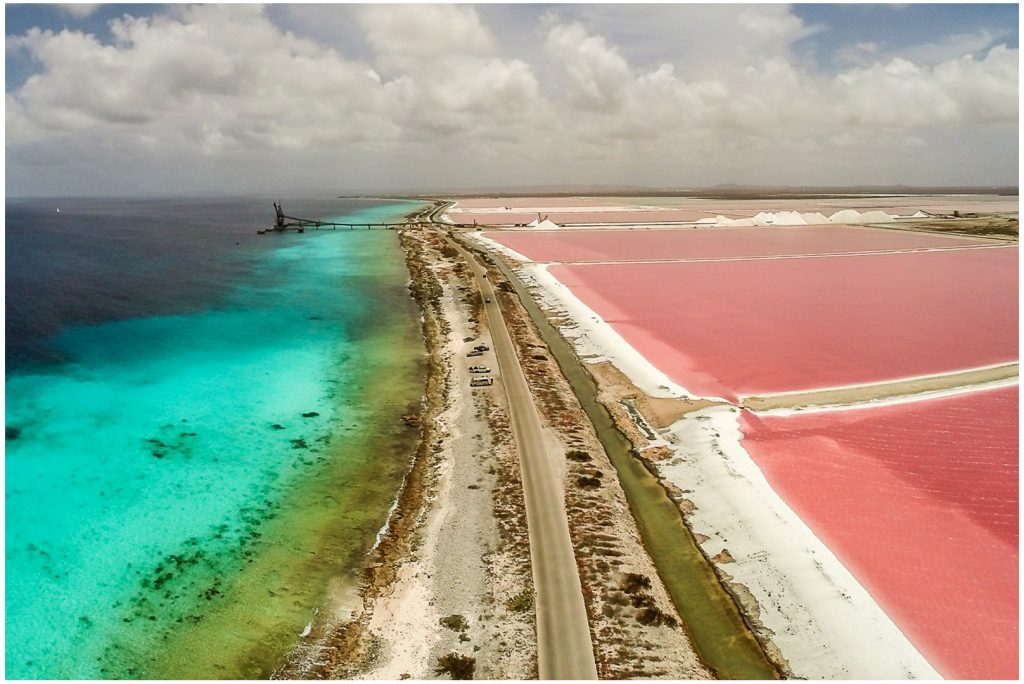As you arrive in Curaçao you will read Welcome to Kura Hulanda Museum. This museum is concerned with the history of slavery in the West Indies . No traveller should miss it.

Huts for the slaves in salt production on Bonaire (Foto © Luc Bosma)
Following the advice of our ship lector, we went to the Kura Hulanda Museum in the morning, directly after our arrival in Curaçao. And it was well worth it. In Willemstad‘s city district of Otrabanda, you will find the biggest anthropological museum of the Caribbean, the ”Kura Hulanda Museum Kura Hulanda Museum“.
On more than 16,000 square metres and in 15 different buildings, you can inform yourself about the history of those people who, between the 17th and 19th centuries, were captured in their African home countries and, after transport across the Atlantic Ocean, ended up as slaves in Curaçao. The “West Indian Company” played a huge role in the process and Curaçao soon became the biggest slave market on the American continent.
The Facts:
The entry fee for the museum is 10 US Dollars, people who are older than 70 only pay 7 US Dollars. We invested the three dollars we had thus saved in a guide (who costs three USD per person if you were a group). It is a good investment.
The Museum:
We were immersed in the dark past of the island but also of humanity and were deeply moved when we left the museum.
I had never before seen in such drastic detail how slavery used to work. In the museum, you can see how the slaves were captured in Africa and then shipped to the New World. Due to its geographical characteristics, the Caribbean was probably a very important slave market.
On the Caribbean Islands, for instance on Curaçao, other things were traded besides slaves. The invaders from Europe had more or less exterminated the original inhabitants. Consequently, a workforce for producing such sought-after products as sugarcane, bananas, spices, salt (especially on Bonaire) was badly needed. And the slave markets were the most obvious place for recruiting such a workforce.
The museum shows how brutally the slaves were treated and traded. How they were cuffed and hunted, what methods (and tools) were used for disciplining them. And also how the owner branded them.
You can also see how slavery was abolished. In the French sector, this even happened twice, because Napoleon had re-established it. Incidentally, the last colonial masters to abolish slavery were the Dutch.
We also found ownership certificates from German-East-Africa. Those are typical German documents where, as late as 1913, it was officially stated that the owners (former slaves) were allowed to decide upon their own destiny from the issuing date onwards.
Naturally, they still needed a workforce in the Caribbean, even after slavery was abolished. The necessary workers were then billed in India. And the owners of the sugarcane and rum plants soon found out that the new workers were even less expensive than the slaves had been. Because now these workers had to provide for themselves. Now an evil and provocative person could say that the abolishing of slavery, too, did not happen entirely for “virtuous” reasons, but that economic considerations played the major part.
I was so impressed by what I saw in the museum that I totally forgot to take pictures, even though this was explicitly allowed. After the tour, I spent a long time thinking about what I had seen and I did a lot of research.
And I noticed that perhaps slavery and fiefdom are connected. And that slavery is not at all very different from the fiefdom that was practiced in Europe for more than half a millennium as a very self-evident principle. Here, too, you will find a lot of information in the Wikipedia article .
You will discover many surprising details, for instance about the mutual hunting rights among neighbours when it came to catching run-away serfs (slaves?) beyond the border.
You will probably understand that there was basically only one difference between fiefdom and slavery. The article is absolutely worth reading and very shocking.
After having read these things, the reference to our “occidental roots and Christian traditions“ made by politicians sounds like the most stupid sarcasm. Because, at the time, the “C“ also stood for nothing other than slavery and fiefdom. Those were very bleak times. Perhaps our politicians would be well advised to inform themselves a little bit about history, even if, at school, fiefdom was not on the curriculum of history lessons – which was also true for my history lessons.
There is only one difference between the fiefdom in German-speaking and other European countries and the trans-Atlantic slavery:
The slaves were dark skinned and came mostly from Africa. In former times, they were called negroes. According to the church and even according to contemporary philosophers (Kant) they were not humans but animals. At the time of Darwin, it was unimaginable that a refined “English Lady“ might, according to the evolutionary theory, be the descendant of an ape. Animals were so far removed from the ideal of the “human” that you could do with them whatever you wished to. This is also why they were not very enthusiastic about Darwin with his new ideas. And the black persons where just considered animals.
To be sure, the “bond-slaves“ or “bondmen“, who belonged to the owner of the property, were a lower class with no rights. But at least they were considered human. They were domesticated by the upper classes (feudalism, also by the church) also be means of religion. They were “only” the property of other people, either directly or indirectly through the property they lived on.
In the Wikipedia article about bondsmen , you will find some laws and atrocities that, from today’s perspective, look rather odd. One of them is the mutual agreement between municipalities that they can hunt bondsmen who are on the run. You get a clear understand of the meaning of the phrase “town air will make you free“. After all, progress – also technological progress – happened in the town and cities.
Basically, over many centuries, the right to own persons was just as self-evident as we today consider the right to own things like property and the copyright or data protection.
And regardless of the fact that we today are giving the right of ownership more and more strength (especially in favour of artificial persons like concerns), we actually abolished the right to own other persons. Isn’t that remarkable?
One might get the idea that, perhaps, other rights to ownership, too, should be abolished. For instance that goods of the common land, too, should no longer be considered individual property. And that absurdly high amounts of property, too, need to be abolished. And perhaps that the distinction between artificial and natural persons should be made subject to the rule of differentiation in ownership.
Here is a cynical note: On the ships that had sailed from Europe to Africa in order to buy slaves and bring this high insurance freight to the Caribbean, missionaries, too, were among the passengers. They were supposed to bring religion to all those African heathen. On the other hand, said slaves were officially not humans, but game to be hunted.
That is also something you learn in the Kura Hulanda Museum. Consequently, visiting the museum Kura Hulanda left me rather thoughtful.

RMD
(Translated by EG)

